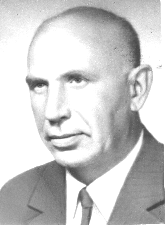 W
WAndrzej Alexiewicz was a Polish mathematician, a disciple of the Lwow School of Mathematics. Alexiewicz was an expert at functional analysis and continued and edited the work of Stefan Banach.
 W
WJerzy Browkin was a Polish mathematician, studying mainly algebraic number theory. He was a professor at the Institute of Mathematics of the Polish Academy of Sciences. In 1994, together with Juliusz Brzeziński, he formulated the n-conjecture—a version of the abc conjecture involving n > 2 integers.
 W
WSamuel Dickstein was a Polish mathematician of Jewish origin. He was one of the founders of the Jewish party Zjednoczenie, which advocated the assimilation of Polish Jews.
 W
WEdward Jan Habich was a Polish engineer and mathematician. In 1876, he founded the National University of Engineering, a renowned engineering school in Lima, Peru. He was a member of the Peruvian Geographic Society and an Honorary Citizen of Peru. In his native Poland he took part in the January Uprising against the Russian Empire in 1863.
 W
WStanisław Jaśkowski was a Polish logician who made important contributions to proof theory and formal semantics. He was a student of Jan Łukasiewicz and a member of the Lwów–Warsaw School of Logic. Upon his death his name was added to the Genius Wall of Fame. He was the President (rector) of the Nicolaus Copernicus University in Toruń.
 W
WBronisław Knaster was a Polish mathematician; from 1939 a university professor in Lwów and from 1945 in Wrocław.
 W
WAdolf Lindenbaum, was a Polish-Jewish logician and mathematician best known for Lindenbaum's lemma and Lindenbaum algebras.
 W
WAntoni Marian Łomnicki was a Polish mathematician.
 W
WJerzy Łoś was a Polish mathematician, logician, economist, and philosopher. He is especially known for his work in model theory, in particular for "Łoś's theorem", which states that any first-order formula is true in an ultraproduct if and only if it is true in "most" factors. In model theory he also proved many preservation theorems, but he gave significant contributions, as well, to foundations of mathematics, Abelian group theory and universal algebra. In the 60's he turned his attention to mathematical economics, focusing mainly on production processes and dynamic decision processes.
 W
WEdward Marczewski was a Polish mathematician. He was born Szpilrajn but changed his name while hiding from Nazi persecution.
 W
WStanisław Mieczysław Mazur was a Polish mathematician and a member of the Polish Academy of Sciences.
 W
WStefan Mazurkiewicz was a Polish mathematician who worked in mathematical analysis, topology, and probability. He was a student of Wacław Sierpiński and a member of the Polish Academy of Learning (PAU). His students included Karol Borsuk, Bronisław Knaster, Kazimierz Kuratowski, Stanisław Saks, and Antoni Zygmund. For a time Mazurkiewicz was a professor at the University of Paris; however, he spent most of his career as a professor at the University of Warsaw.
 W
WMichał Misiurewicz is a Polish mathematician. He is known for his contributions to chaotic dynamical systems and fractal geometry, notably the Misiurewicz point.
 W
WOtto Marcin Nikodym was a Polish mathematician. He was born in 1887 in Demycze, a suburb of Zabłotów, to a family with Polish, Czech, Italian and French roots. Orphaned at a young age, he was brought up by his maternal grandparents. He studied mathematics at the University of Jan Kazimierz (UJK) in Lvov. Immediately after his graduation in 1911, he started his teaching job at a high school in Kraków where he remained until 1924. He eventually obtained his doctorate in 1925 from the University of Warsaw; he also spent an academic year (1926-1927) in Sorbonne. Nikodym taught at the Universities of Kraków and Warsaw and at the Akademia Górnicza in Kraków in the years that followed.
 W
WWładysław Roman Orlicz was a Polish mathematician of Lwów School of Mathematics. His main interests were functional analysis and topology: Orlicz spaces are named after him.
 W
WMojżesz Presburger, or Prezburger, was a Polish Jewish mathematician, logician, and philosopher. He was a student of Alfred Tarski, Jan Łukasiewicz, Kazimierz Ajdukiewicz, and Kazimierz Kuratowski. He is known for, among other things, having invented Presburger arithmetic as a student in 1929 – a form of arithmetic in which one allows induction but removes multiplication.
 W
WPrzemysław (Przemek) Prusinkiewicz is a Polish computer scientist who advanced the idea that Fibonacci numbers in nature can be in part understood as the expression of certain algebraic constraints on free groups, specifically as certain Lindenmayer grammars. Prusinkiewicz's main work is on the modeling of plant growth through such grammars.
 W
WJakob Rosanes was a German mathematician who worked on algebraic geometry and invariant theory. He was also a chess master.
 W
WStanisław Ruziewicz was a Polish mathematician and one of the founders of the Lwów School of Mathematics.
 W
WAndrzej Bobola Maria Schinzel is a Polish mathematician, studying mainly number theory.
 W
WRoman Sikorski was a Polish mathematician.
 W
WWładysław Ślebodziński was a Polish mathematician.
 W
WJan Śniadecki was a Polish mathematician, philosopher, and astronomer at the turn of the 18th and 19th centuries.
 W
WStanisław Solski was a Polish Jesuit mathematician and architect. He published several works in Polish and Latin.
 W
WWłodzimierz Stożek was a Polish mathematician of the Lwów School of Mathematics.
 W
WStanisław Lech Woronowicz is a Polish mathematician and physicist. He is affiliated with the University of Warsaw and is a member of the Polish Academy of Sciences.
 W
WStanisław Zaremba was a Polish mathematician and engineer. His research in partial differential equations, applied mathematics and classical analysis, particularly on harmonic functions, gained him a wide recognition. He was one of the mathematicians who contributed to the success of the Polish School of Mathematics through his teaching and organizational skills as well as through his research. Apart from his research works, Zaremba wrote many university textbooks and monographies.
 W
WWawrzyniec Żmurko was a Polish mathematician, professor of Lviv University and Lviv Polytechnic, honoris causa of Lviv University, member of Polish Academy of Learning. He was a president of Polish Copernicus Society of Naturalists (1879-1881). In 1885-1886 he was Rector of the Lviv University. He was the father of a painter, Franciszek Żmurko.